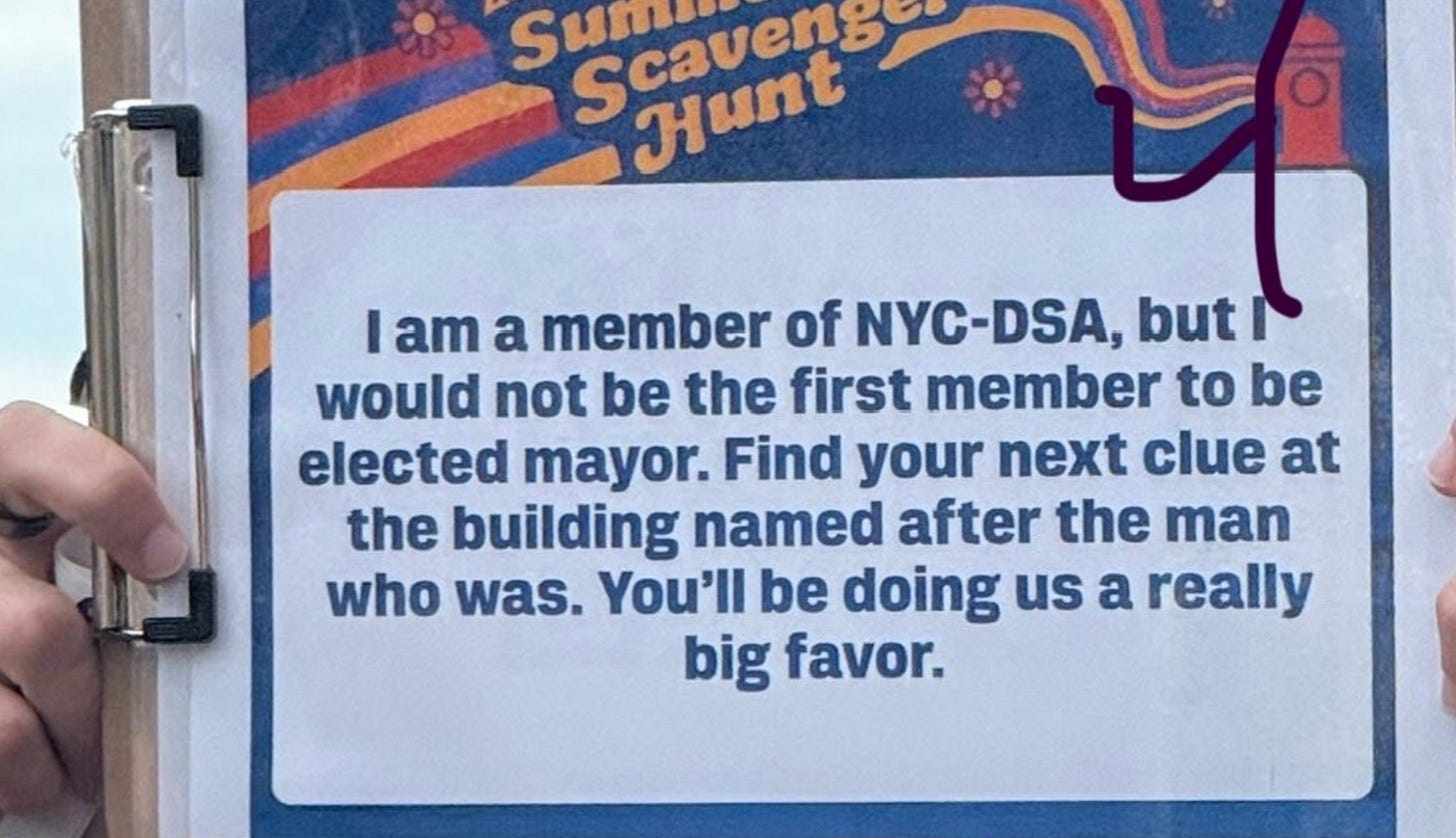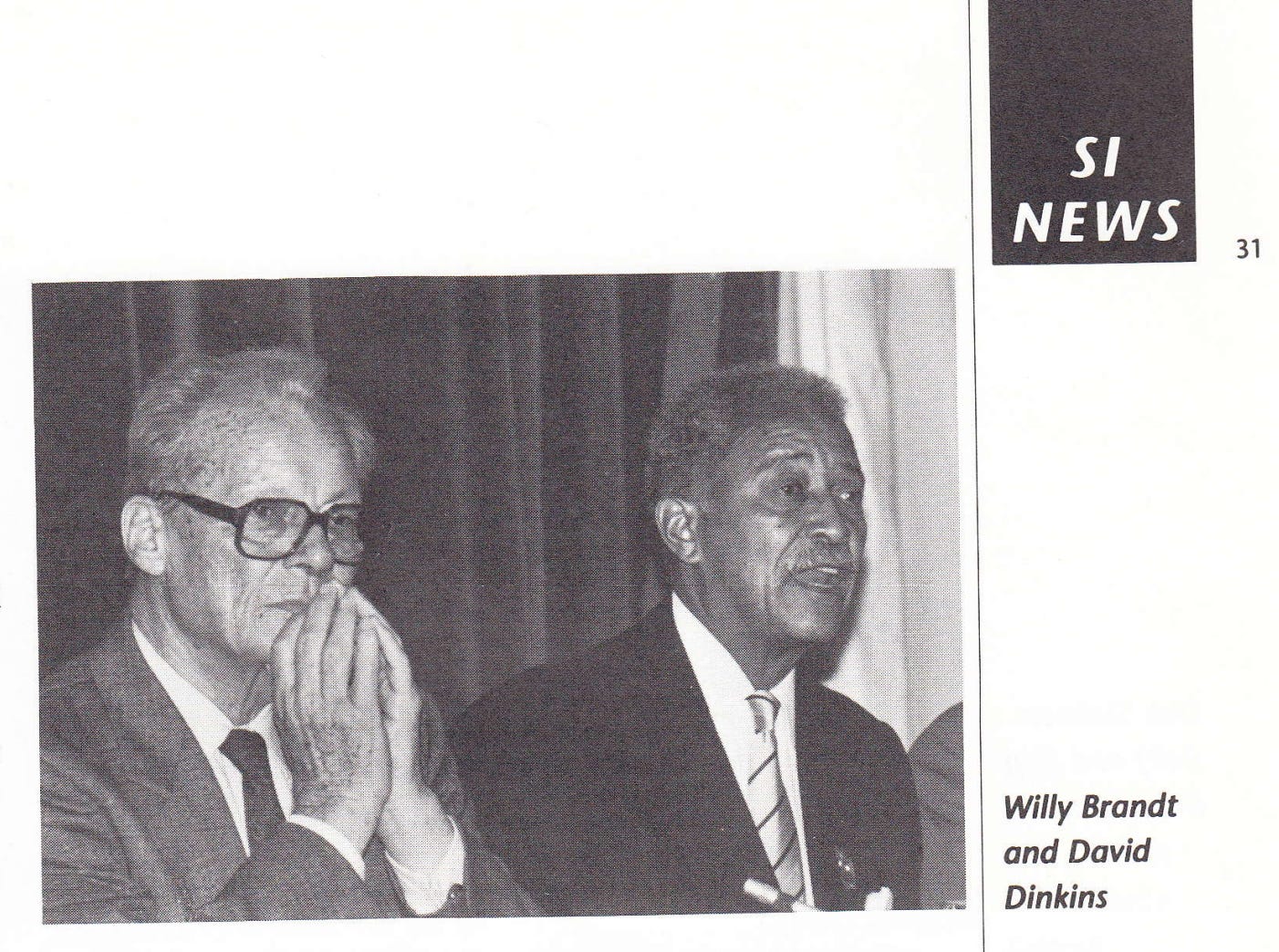Zohran’s Scavenger Hunt and the Forgotten Socialist Mayor of New York
A citywide scavenger hunt turned contained a mini-history lesson about New York’s socialist lineage.
Clue 4 at Zohran Mamdani’s citywide scavenger hunt, volunteers lifted a white placard above the crowd:
Phones came out, guesses flew, and the river of people walked quickly toward the David N. Dinkins Manhattan Municipal Building. The clue contained a reference to A Tribe Called Quest lyric—“Mr. Dinkins, would you please be my mayor? You’ll be doing us a really big favor”—and the whole thing felt like a city in on a joke about itself.
The punch line was also a lesson. David Dinkins, the 106th mayor of New York and the city’s first Black mayor, was a member of Democratic Socialists of America. The clue worked because it restored a small piece of civic memory to the map, reminding a nervous present that this kind of politics has lived here before and the trains kept running on time.
In October 1991, the Socialist International, a global association of social-democratic, socialist, and labor parties, held its first U.S. meeting in New York City on October 8–9 under the theme “Bridging the North–South Divide: New Economic Relations for the 1990s.” Mayor David Dinkins welcomed the delegates and situated New York in a global struggle for justice.
“Your unique vision and commitment to social and economic democracy throughout the world have marked this century,” Dinkins said. “After decades of struggle, your dream of a world liberated from the crushing weight of fascism and totalitarianism is quickly becoming a reality – from the shanties of Soweto to the crumbling bricks of the Berlin wall.”
Dinkins honored Michael Harrington, DSA’s founder, who had died the year before: “Today, we must rededicate ourselves to Michael’s mission – to close the yawning gaps that exist between the rich and the poor in so many nations around the world. I first met Michael during the civil rights movement, when the American Socialist Party garnered its forces in the struggle for equality and justice led by the Reverend Doctor Martin Luther King Junior.”
Dinkins tied economic justice to racial justice: “Of course, poverty knows no race or national origin, but it is a stinging fact that, in this country, economic deprivation and race too often go hand-in-hand.”
And Dinkins stated the ethic at the core of democratic socialism: “The tradition of democratic socialism tells us that the accident of birth must never condemn a human being to poverty, sickness, or lack of hope.”
Dinkins’s relationship to this tradition wasn’t ceremonial. DSA’s magazine described him in 1989 as a “longtime DSA member.” When the Socialist International gathered in New York, he said plainly: “I am delighted to be joined by my friends from the Democratic Socialists of America, who have been strong supporters of mine all along.” He also welcomed Willy Brandt, placing New York’s fight against poverty alongside Europe’s social-democratic project.
So when critics call Mamdani’s DSA affiliation radical and unprecedented, Clue #4 is a neat rebuttal. New York has walked this road. DSA today is not the same organization it was during Dinkins’s tenure. But the lineage runs deeper: Fiorello La Guardia won reelection to Congress in 1924 on the Socialist Party line after backing La Follette; the House clerk listed him as Socialist and Victor Berger joked La Guardia was “my whip.” His campaign manager, Vito Marcantonio, later represented East Harlem in Congress with the American Labor Party and became the city’s most durable left third-party figure in Washington. Robert Wagner Jr.’s City Hall rested on unions such as 1199, ILGWU, and DC 37, where socialists and communists were influential. The city’s housing, labor, and public-health gains of the New Deal era were built on that labor-left backbone.
Dinkins closed his Socialist International remarks with thanks “for caring about the problems that all nations share.” He was reminding the city that its struggles were connected to internationalism, from Soweto to Berlin, and that New York could choose solidarity over fear.
Mamdani’s scavenger hunt turned that reminder into a day in the streets. It sent thousands through parks and plazas and, for a moment, stitched history to the present. The panic about a “Socialist Mayor” eases when you remember what Dinkins said in 1991: “At a time when inequities are on the rise in this, the richest nation on earth, we in the City of New York remain committed to social and economic justice.”
That is the tradition Clue #4 pointed back to—less a provocation than a footnote with a wink and smile. New York has lived with socialists before, and the trains still ran. If there is any crisis here, it is one of memory. The clue offered the cure and the cue: read the plaque, follow the map Dinkins left, and, as the Tribe lyric that inspired it suggests, do the city a really big favor.






David Dinkens' legacy narrative has largely been written by his political opponents - ie, the Rudy Giuliani Republicans, ADL and allied groups, and the NYC police union (NYC PBA). Unfortunately, Mayor Dinkins lost control of his own story early on in his single term as Mayor. I don't think it helps Zohran Mamdani very much to use David Dinkens as a metaphor for his own campaign to be NYC's Mayor.
Interestingly, when Mandami won the primary, Chat GPT said he would be the first socialist mayor in NYC history., ignoring Dinkins. They've now corrected it and portray it pretty accurately
https://chatgpt.com/c/68aca0b7-c66c-8321-a693-61970b774fef
Agree that the Dinkins legacy got written by his opponents, so he left pretty unpopular, but his tenure proves the point that none of the predictions of doom came true.